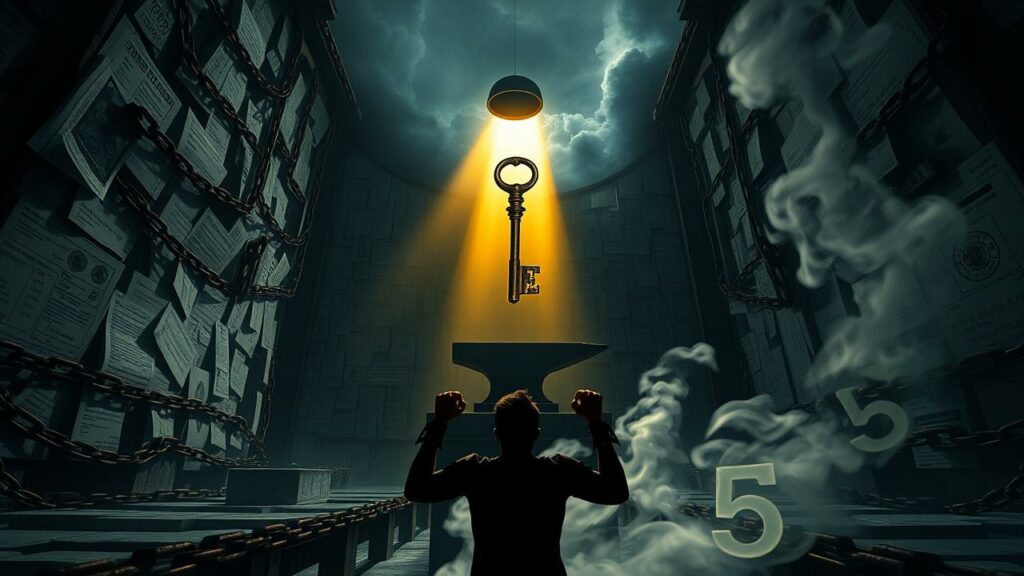The Unvarnished Bottom Line
You’re not looking for a lecture; you’re looking for a lever. A way to move this impossible weight. Debt consolidation rolls your multiple, high-interest debts—credit cards, personal loans, medical bills—into one new loan. The goal: a single monthly payment, a lower overall interest rate, and a clear finish line. It’s a tool, not a cure. Used wisely, it carves a path out of the jungle. Used recklessly, it just leads you deeper into the trees. This is about understanding the map before you take the first step.
The Mechanics of a Cease-Fire
At its core, debt consolidation is a strategic retreat to a more defensible position. You’re not erasing what you owe; you’re restructuring the battle. Instead of fighting on five different fronts against predatory credit card APRs and unpredictable payment dates, you obtain one new loan—ideally with a lower, fixed interest rate—and use it to wipe out the other balances.
The sudden silence is jarring. No more juggling due dates. No more deciding which company gets paid and which one has to wait. Just one payment. One creditor. One date on the calendar. This simplicity is the primary benefit. It frees up the mental bandwidth that debt so viciously consumes, allowing you to focus on the actual fight: paying down the principal.
A lower interest rate is the second, and arguably more powerful, prize. If you’re paying 24% on three different credit cards, securing a personal loan at 11% means more of your money attacks the debt itself, not the parasitic interest feeding on it. Your payments start making a real dent, creating the momentum needed to see this thing through to the end.
Picking Your Weapon
There isn’t a one-size-fits-all solution, just different tools for different situations. Your credit score, income, and the sheer-mass of your debt will dictate your options.
- Personal Loans: This is the classic method. You borrow a lump sum from a bank, credit union, or online lender to consolidate credit card debt and other unsecured loans. They typically have fixed interest rates and a set repayment term (e.g., 3-5 years), giving you a predictable target.
- Balance Transfer Credit Cards: Some find a perverse irony in using a credit card to pay off credit cards. But for those with good credit, a card offering a 0% introductory APR for 12-21 months can be a powerful tool. You transfer your high-interest balances to the new card and attack the principal with everything you’ve got before the introductory period ends and the regular (and often high) interest rate kicks in. A dangerous game if you’re not disciplined.
- Home Equity Loans or HELOCs: Using your home as collateral can secure a loan with a very attractive, low interest rate. It’s also fantastically risky. If life throws you a curveball—a job loss, a medical emergency—and you falter on the payments, you aren’t just dealing with collectors. You’re facing foreclosure. You’re betting your shelter on your ability to pay.
- 401(k) Loans: Borrowing from your future self. It seems easy, with no credit check and low interest rates. But you’re pulling money out of the market, losing potential growth, and if you leave your job, the entire loan is often due in a short period. It’s a move born of desperation, and it can mortgage your future to solve a problem of the present.
The Moment of Truth: Is This For You?
A backhoe loomed outside the window of the rental apartment, its diesel engine a dull throb that vibrated through the floor. It was a fitting soundtrack for the pressure building inside Dalton’s skull. A long-haul trucker, his entire life existed in a 400-square-foot apartment and the cab of his Peterbilt. Piled on the passenger seat of his rig were months of ignored envelopes—credit card statements, a menacing letter about a defaulted medical bill, and a final notice from a personal loan he took out after his divorce. The total was north of $30,000, a number so large it felt unreal, like a statistic from a news report, not his own life. The thought of sorting through it all made him feel dizzy, a strange land-sickness after weeks on the open road. He felt trapped, not by the cab of his truck, but by the relentless paper chain of his own bad decisions and worse luck.
For Dalton, the chaos was the enemy. He had a good, steady income. His credit, while bruised, wasn’t destroyed. The problem wasn’t a lack of money, but a lack of organization and the crushing psychological weight of so many moving parts. A single, fixed payment from a debt consolidation loan wouldn’t just lower his interest rate; it would give him a single target. A hill to take. For him, it represented a way to simplify the fight, to turn the tide. It was a lifeline he could grab onto.
But what about you? Ask the hard questions. Is your credit score strong enough to qualify for a loan with an interest rate lower than what you’re currently paying? Have you addressed the habits that led to the debt in the first place? Consolidation is pointless if you just run up the balances on your newly freed-up credit cards. Be brutally honest with yourself. This isn’t just a math problem; it’s a behavior problem. If the math works and you’re ready for war with your old self, it might be your best path forward to get out of debt.
A Dose of Hard Reality
The marketing around consolidation can feel like a siren’s song, promising a painless escape. But the reality is far more complex, with potential traps for the unwary. This video breaks down the pros and cons with the frankness you need, exposing the ‘cons’ in consolidation that companies don’t advertise.
Source: Debt Consolidation Pros and Cons: The Harsh Truth via Ascend on YouTube
The Serpent in the Garden
The flyer came tucked in a supermarket circular, rendered in cheerful blues and greens. “ONE EASY PAYMENT! BECOME DEBT FREE!” it chirped. For Lennon, a gig worker stitching together a living from graphic design projects, it felt like a prayer answered. The pandemic had ravaged her client base, and she’d been living on credit for the better part of a year. The call was so easy. The agent was soothing, promising to talk to her creditors, to reduce what she owed. She signed up, a wave of pure, unadulterated relief washing over her. All she had to do was stop paying her cards and put a set amount into a special savings account each month. Simple.
The relief lasted three months. Then the calls started—not from the “program,” but from unknown numbers, angry voices on the other end. Her credit score, once fair, had plummeted into the abyss. A hollow dread formed in her stomach. Scouring online forums, she found her story echoed by hundreds of others. She hadn’t signed up for a consolidation loan. She’d been duped into a debt settlement program. Her accounts were being intentionally defaulted to force them into collections, where the company would then try to negotiate a lower settlement, taking a hefty fee for the service. The cheerful flyer was a lie. She had paid a stranger to ruin her credit and invite a plague of collectors into her life. Her problem wasn’t just unsolved; it was magnified, mutated into something far more monstrous.
This is the dirty secret of the industry. Many so-called debt relief programs are not your allies. They thrive on the charge-offs and the damage to your credit. A legitimate debt consolidation loan is from a reputable lender like a credit union or bank. It pays off your old debts immediately. Anything that tells you to stop paying your creditors is not consolidation; it’s a high-stakes gamble with your financial future.
When the Main Gate is Barred
What if you can’t get a consolidation loan? What if your credit is already shot, or your income isn’t high enough to qualify? This is not the end. It’s the point where you have to get creative and disciplined. You become the architect of your own consolidation, without a formal loan.
You stop waiting for a hero. You become one.
This is where methodical approaches come into play. Two of the most proven are the debt snowball method and the debt avalanche method. With the snowball, you list your debts from smallest to largest balance, ignoring interest rates. You make minimum payments on everything except the smallest debt, which you attack with every spare dollar. Once it’s paid off, you feel a surge of victory. You then roll that entire payment amount onto the next-smallest debt. The “snowball” gets bigger and bigger, building momentum and psychological wins.
The avalanche is for the pure rationalist. You list debts by interest rate, highest to lowest. You attack the highest-rate debt first, saving the most money in the long run, but the wins can feel slower. Another powerful alternative is a debt management plan (DMP) through a non-profit credit counseling agency. They work with your creditors to lower interest rates and formulate a single monthly payment you make to the agency, who then distributes it. It’s structured, and it might temporarily close your cards, but it’s a legitimate and highly effective route for those who need a helping hand.
The Scars That Remain: Credit Score Impact
Will consolidation hurt your credit? It’s the wrong question. The right question is: will it hurt less than the slow-motion train wreck you’re currently experiencing? The answer is almost always yes.
Initially, you’ll likely see a small, temporary dip. Applying for a new loan generates a “hard inquiry” on your credit report. Opening a new loan also lowers the average age of your accounts. Both of these can cause a minor drop.
But what happens next is what matters. You’ve just paid off several revolving credit lines (your credit cards), which dramatically lowers your “credit utilization ratio”—a major factor in your score. Instead of having cards maxed out at 95% of their limit, they’re now at zero. This is a massive positive. Over time, as you make consistent, on-time payments on the new consolidation loan, your score will not only recover but will likely climb higher than it was before. It’s a strategic wound that promotes healing, a necessary step in the broader quest to build a healthy financial independence roadmap.
You Are the Unbreakable Variable
The kitchen table was a battlefield of paper. Pay stubs, bank statements, and a terrifying stack of credit card bills were spread under the harsh fluorescent light. For Abraham, a forklift operator on the night shift, and his wife Gracelyn, a daycare assistant, this was it. The breaking point. The quiet resentment over money, the snippy comments, the feeling of running in place—it had all come to a head. The numbers didn’t lie. They were drowning.
They found an online debt payoff calculator and, for the first time, entered every single debt. The final figure was sickening. A personal loan for consolidation seemed possible, but the monthly payment was still a huge chunk of their combined income. It wasn’t a magic wand. Abraham’s shoulders slumped. “It’s still too much,” he said, the fight draining from his voice. But Gracelyn pushed a legal pad into the center of the table. “Okay,” she said, her voice firm. “Then we make it fit.”
What followed was a brutal, honest, and oddly unifying process. They cut streaming services, canceled gym memberships they barely used, and planned every single meal for the month. They looked at their budget not as a prison, but as a flight plan. The consolidation loan wasn’t the solution; it was the vehicle. The real work was changing their flight path, their habits, their mindset. It was the hardest thing they’d ever done as a couple. And it was the first time in years they felt like they were a team, fighting for the same future. This is the heart of all debt elimination strategies; the tool is useless without the will to wield it. You have to learn the essential tips to avoid debt in the future, or you’re just clearing the field for a new crop of problems.
Questions From the Trenches
Is it a good idea to do debt consolidation?
It’s a good idea if it accomplishes two things: lowers your overall interest rate and simplifies your payments in a way that helps you attack the debt more effectively. If you’re disciplined and your credit is good enough to get a favorable loan, debt consolidation can be a brilliant strategic tool. If you see it as “freeing up” your credit cards to be used again, it’s a catastrophic mistake. It’s only a good idea if it’s paired with a rock-solid budget and a commitment to stop creating new debt.
How much is the payment on a $50,000 consolidation loan?
There’s no single answer. It’s a function of interest rate and loan term. For example, a $50,000 loan over 5 years (60 months) at 9% APR would be around $1,038 per month. Stretch that to 7 years (84 months) at the same rate, and the payment drops to about $799, but you’ll pay thousands more in interest over the life of the loan. A higher interest rate, say 15%, would push that 5-year payment to over $1,190. Use a loan calculator before you ever apply to see if the numbers are realistic for your budget.
Does consolidation hurt your credit?
Think short-term dip, long-term gain. You’ll take a small hit initially from the loan application (hard inquiry) and the new account lowering your average credit age. However, paying off multiple credit cards at once can drastically slash your credit utilization ratio, which is a huge positive for your score. As you make consistent on-time payments, your score will not only recover but will likely climb higher than it was before. The temporary damage is almost always less than the ongoing damage of maxed-out cards and potential missed payments.
What’s the real difference between debt consolidation and debt settlement?
Night and day. Debt consolidation is getting a new loan to pay off credit card debt and other existing loans in full, right now. Your old accounts are closed with a zero balance. Debt settlement is hiring a company to negotiate with your creditors to accept less than what you owe. This requires you to stop paying your bills, which trashes your credit score, invites collection lawsuits, and there’s no guarantee the creditors will even agree to settle. One is a financial strategy; the other is a high-risk financial battlefield.
Armory for the Mind
The fight is mental as much as it is financial. These aren’t just books; they are manuals for rewiring your brain and rebuilding your life.
- The Complete Idiot’s Guide to Getting Out of Debt by Ken Clark: Don’t let the title fool you. This is a brilliant, shame-free guide that breaks down complex topics into actionable steps. It feels like getting advice from a wise, non-judgmental friend.
- The Debt Relief Playbook by Mark Wesbrooks: For those feeling besieged by collectors, this book is a shield and a sword. It’s an aggressive, empowering look at using consumer protection laws to defend yourself.
- Budget Management for Beginners by Joel Jacobs: Forget everything you think you know about budgeting. This book reframes it not as restriction, but as a blueprint for freedom, helping you stop the paycheck-to-paycheck cycle for good.
Maps and Guideposts
You are not the first person to walk this path. Here are links to tools and communities that can help light the way.
- Discover Debt Consolidation Calculator: Run the numbers. See what a new loan payment could look like before you get your hopes up.
- U.S. Bank Debt Consolidation Info: A solid overview from a major lender on how the process works.
- Federal Student Aid: If federal student loans are your primary burden, start here. The rules are completely different.
- MyCreditUnion.gov: Credit unions often have better rates and more flexible terms than big banks. This is a great resource.
- CFPB on Debt Relief Options: The Consumer Financial Protection Bureau provides unbiased definitions of consolidation, settlement, and counseling.
- r/personalfinance: A massive Reddit community for financial questions. Search before you post; your question has likely been answered a dozen times.
- r/debtfree: A place for inspiration, success stories, and commiseration with people on the same journey.
Your First Step
The weight won’t vanish overnight. But you can make it lighter, starting now. Forget the five-year plan. Focus on the next five minutes. Grab a piece of paper—not a spreadsheet, a physical piece of paper. Write down one debt. Just one. The smallest one. Look at the number. Now, decide on one thing—one single, small expense—you can cut this week to throw a few extra dollars at it. That’s it. That’s your first move. This is how you begin to reclaim your power. Not with a grand gesture, but with a single, deliberate act of defiance. The journey of debt consolidation, and of financial freedom, begins not with the loan, but with the decision to fight back.







